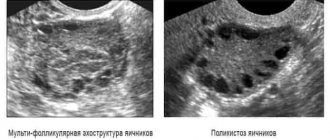Pregnancy, children > Preparing for pregnancy > Planning pregnancy > Ovulation > Ovulation test: how it works and when to do it
Today, there are many known methods for determining ovulation (the day a mature egg, ready for fertilization, is released from a ruptured follicle into the abdominal cavity). Ovulation tests are considered one of the most accurate ways to determine the period favorable for fertilization. Their reliability is estimated at 99%. What is the principle of operation of these tests, when to conduct them and how to evaluate the result, we will consider in detail in the article.
What is ovulation?
Ovulation is a process that occurs only once per cycle when, as a result of changes in the amount of hormones, an egg is released from the ovary. As a rule, ovulation occurs 12-16 days before the “arrival” of the next menstruation. Before ovulation, a woman's body produces large amounts of a hormone called estrogen, which causes the lining of the uterus to grow and helps create a suitable environment for sperm.
Increased estrogen levels cause luteinizing hormone (LH) levels to rise. Its release provokes the release of an egg from the ovary, resulting in ovulation. Fertilization can occur within 24 hours after this process. If this does not happen, the overgrown membrane peels off and menstruation begins. From the first day of menstruation, a new cycle begins.
Accuracy is the key to success
The entire process of determining the level of luteinizing hormone takes about three minutes, and the accuracy of the test is maximum - it is more than 99 percent. The strips are very sensitive to changes in the female body; they determine the presence of the hormone in a concentration of 30 mIU/ml. But there are many subtleties associated with determining the onset of ovulation.
- It is best to check your hormonal balance at the same time.
- It is not recommended to use the first morning urine. This is explained by the fact that luteinizing hormone is formed in the body early in the morning and is excreted in the urine a little later during the day.
- Another tip on how to use an ovulation test is to reduce the amount of liquid approximately two to three hours before using the test strip. In addition, you should not go to the toilet for at least four hours before the test.
By the way, sometimes you can find several pregnancy tests in the box. There are also special hygienic containers that are hermetically sealed. This helps to use the test in any restroom or outdoors. There is also a corresponding video on how to use the ovulation test.
When using an ovulation test, you need to know that every woman experiences “glitches.” The fact is that the ideal time for conceiving offspring does not occur every month. Several times a year, the release of an egg from the ovary simply does not occur, and this is absolutely normal.
However, the absence of ovulation for three to four months in a row is a reason to go to the doctor. Among the main reasons that lead to disruptions in the natural course of events are various diseases of the endocrine system, polycystic ovary syndrome, as well as inflammatory diseases of the genital area and genetic abnormalities. If you pay attention to these ailments in time, they will not be able to interfere with the birth of a child. After all, in our time there are very few cases where doctors make the terrible diagnosis of infertility. And, as experience shows, they are often mistaken in their pessimistic forecasts.
Why is the test necessary?
When planning to carry a baby, you should know that in each cycle there are only a few days favorable for conception. And this is only 2 days when ovulation occurs. Every woman ovulates on different days. An ovulation test will help determine them.
There are many ways to identify this favorable time. However, many of them are ineffective or require tests (blood tests or scanning with an ultrasound machine). For example, measuring basal temperature - you can’t count on it, since an increase in such temperature occurs only after ovulation.
Ovulation tests can be performed at home and do not require special knowledge or skills.
How to plan the gender of a child using a test?
Of course, it is impossible to plan the gender of your child with a 100% guarantee. But there is a theory that conceiving on days close to ovulation will increase the chances of having a male baby, and on the most distant days a female baby. To increase this likelihood, it is necessary to make love strictly on certain days.
How to use an ovulation test if you want a girl? After the test gives a positive result, you must abstain from sexual intercourse until pregnancy occurs. If pregnancy does not occur, then everything should be repeated in a new cycle.
How does an ovulation test work?
During the cycle, the follicle matures in the ovary. While it matures, estrogens are produced in its cell. When their level is maximum, LH is released. Then, within 1-2 days, the follicle ruptures - ovulation occurs. The egg, which seeks fertilization, begins its movement through the fallopian tube to meet sperm.
This test responds to LH levels. This hormone is always present in a woman’s body in small quantities. Its significant increase is provoked by ovulation. 24-36 hours before this process, the concentration of LH reaches its peak.
Thanks to the test, you can find out about this increase and determine when the most favorable time for conceiving a child will come.
It is immediately worth noting that it is inappropriate to use this test as a means of protection against unwanted pregnancy. This is explained by the fact that in a woman’s body, sperm retain their activity and functions for several days. It is for this reason that this method of contraception may be ineffective.
What is the action based on?
The principle of operation of such a test is to detect an increase in the concentration of luteinizing hormone (LH) in a woman’s blood. Its high level is observed in the urine 24-36 hours before the release of a mature egg from the ovary. Accordingly, within the next 2 days the best time for conception comes. Moreover, the accuracy of most of these tests is 99%.
However, there may be false results associated with a woman taking certain hormonal medications (for example, the pregnancy hormone hCG gives a positive response). An increase in LH can also occur in other cases, such as: hormonal dysfunction, postmenopause, renal failure, etc.
For what reasons is ovulation disrupted?
Ovulation failure can occur for several reasons. For example, anovulation can occur in the following cases:
- with hormonal imbalance;
- dysfunction of the ovaries;
- dysfunction of the thyroid gland;
- when carrying a baby;
- after the birth of a child;
- under stress;
- after an abortion;
- for systemic diseases;
- when menopause occurs.
To bring ovulation back to normal, you need to contact a gynecologist who will find out the cause of this deviation and also prescribe the necessary treatment.
What types of tests are there?
An ovulation test can be purchased at any pharmacy. However, this is where the difficulty arises: which one to choose, since there are so many of them?
Main types of ovulation tests:
- test strips resemble a pregnancy test and look like narrow strips made of special paper that is impregnated with a reagent. To use, you need to immerse it in a container with urine for 5-10 seconds, after a while you can observe the result;
- test tablets (or cassettes), which are a plastic container with a small window. In this case, you can not collect urine, but simply place the tablet under the stream or drop a little into the window, in which the result will then appear;
- reusable tests are a portable device that includes a large number of test strips. The strip is sent into the urine and then placed in a device that shows the result;
- electronic tests give a reaction not to urine, but to saliva. A small amount of saliva is placed under the lens, and then the resulting pattern is examined using a microscope. The instructions contain a complete and accurate description of each possible pattern.
Almost every test includes 5 strips or cassettes, since it is quite rare to detect ovulation the first time.
Each test has instructions for use, so be sure to read them. Many manufacturers even present videos on the rules of the test on their websites.
Operating principle
All types of tests (including Frautest) operate according to the same mechanism and have the same level of sensitivity. At the same time, they should be used strictly according to the instructions provided. She will tell you how to work with reagents correctly. The test contains a number of antibodies that determine the concentration of luteinizing hormone in urine.
The test is often used to plan the gender of the unborn child. Conceiving on the eve or in the first days of ovulation increases the likelihood of having a boy. Sexual contact at a later time helps to conceive a girl. However, these observations cannot be considered a pattern.
Subtleties of use
Before using an ovulation test, it is recommended to consider the following nuances:
- Testing should not be done while taking hormonal medications. Hormonal drugs reduce the reliability of the result.
- The quality of the result is affected by hot weather and excessive fluid intake. In such circumstances, the frequency of urination increases and the concentration of luteinizing hormone decreases.
- The main guide is the instructions. Therefore, you must read it carefully before using the testing device.
- The reliability of the result depends on the reagent itself. Morning urine is not effective. To obtain more accurate information, the last emptying of the bladder should take place 3-4 hours before the test.
- A positive result indicates that ovulation will occur in the next 48 hours. It is important not to waste time.
- If the device is exposed to a damp environment or its packaging is damaged, it becomes unusable.
- An ovulation test is only useful if you have a regular menstrual cycle.
When and how to test
With a regular menstrual cycle, the time of ovulation depends on its duration. Ovulation often occurs in the middle of the cycle. When determining the time of ovulation, refer to the attached instructions. The instructions may contain an approximate calculation of the days of ovulation based on the menstrual cycle:
- If the cycle lasts 28 days, the egg matures on the 14th day. Ovulation occurs between 11 and 13 days after the start of menstruation.
- When the cycle length exceeds 28 days, 17 days should be subtracted from the next expected date of menstruation.
- If the cycle is irregular, the calculation is based on the shortest menstrual cycle over the past six months.
The instructions will also tell you how to carry out an ovulation test. This process often consists of several stages:
- Collect urine in a container.
- Opening the package (recommends paying attention to the appearance of the dough. There should be no damage to it).
- The test is placed in a container with urine for a few seconds. The exact residence time of the dough in the container is indicated in the attached instructions.
The package contains 5 copies. Testing should be done every 12 hours throughout the calculated ovulation period. This will reveal the most favorable time for conception.
How to do the test?
An ovulation test, unlike a test that confirms or denies pregnancy, is performed not once, but twice a day for seven days. This is explained by the fact that the maximum LH level lasts about 24 hours and can be both in the morning and in the evening. It is for this reason that experts recommend doing this test both in the morning and in the evening. This will allow you not to miss the moment when the body has the most luteinizing hormone.
Many girls are concerned about the question of when to start such testing. Doctors say you should start testing 17 days before your period starts. For example, if the cycle is 28 days, then the test should be performed for the first time on the 11th day of the cycle.
The test should be done every day until a positive result is obtained. This causes a very important drawback of these tests - unfortunately, they are not suitable for women who have an irregular cycle.
Mathematics is the queen of sciences
To start using the Frautest ovulation test, you need to understand that they begin to monitor hormonal balance not from the first day of the menstrual cycle, but closer to its middle.
To choose the best moment, you need to calculate how many days the entire menstrual cycle lasts (from the first day of menstrual bleeding) and subtract 17 from the resulting figure. For example, with a 30-day cycle, the test is carried out from the 13th day.
In cases where a girl simply cannot determine the number of days because every month or month and a half her body gives her “surprises,” they calculate based on the shortest cycle over the last six months.
If within five days an increase in the hormone could not be detected, you need to continue testing for several more days.
What other rules should be followed to conduct the test correctly?
- the test should be done every day and at the same time;
- The ideal period for testing is considered to be between 10 am and 8 pm;
- if you are using urine for testing, you should not use the first portion in the morning;
- Before the procedure, review the medications you are taking. If they contain LH, there is no point in conducting the test;
- 1-4 hours before testing, do not drink much liquid;
- Before testing, it is advisable not to visit the toilet for 3 hours.
The result of an ovulation test.
The test result (line) must be compared with the control line. If it is pale, it means that the LN has not yet been released. In this case, it is necessary to continue testing.
If the resulting line is the same color as the control line, or even darker, this indicates that a surge has occurred and ovulation will occur within 1-1.5 days.
These days after the release of the hormone are the best for conception, since the chance of getting pregnant is maximum.
Can the test show an incorrect result?
Unfortunately, ovulation tests may not show the onset of ovulation, but only changes in LH levels. Of course, a sharp increase in this hormone is the main factor in the beginning of this process. However, a sharp rise in LH does not guarantee that ovulation has occurred.
When can an increase in hormone levels occur?
Such tests may give false positive results if:
- postmenopause;
- with a sudden transition to vegetarianism;
- with renal failure;
- in case of hormonal imbalance;
- after hCG injections;
- after stopping taking synthetic drugs that contain hormones;
- with ovarian depletion.
For this reason, if you are missing your period or suspect a hormonal imbalance, you should not rely only on the result of an ovulation test. In this case, only ultrasound examination can provide accurate results.












